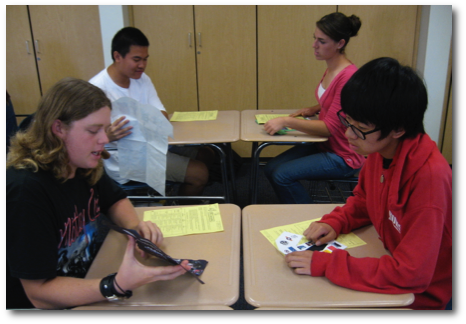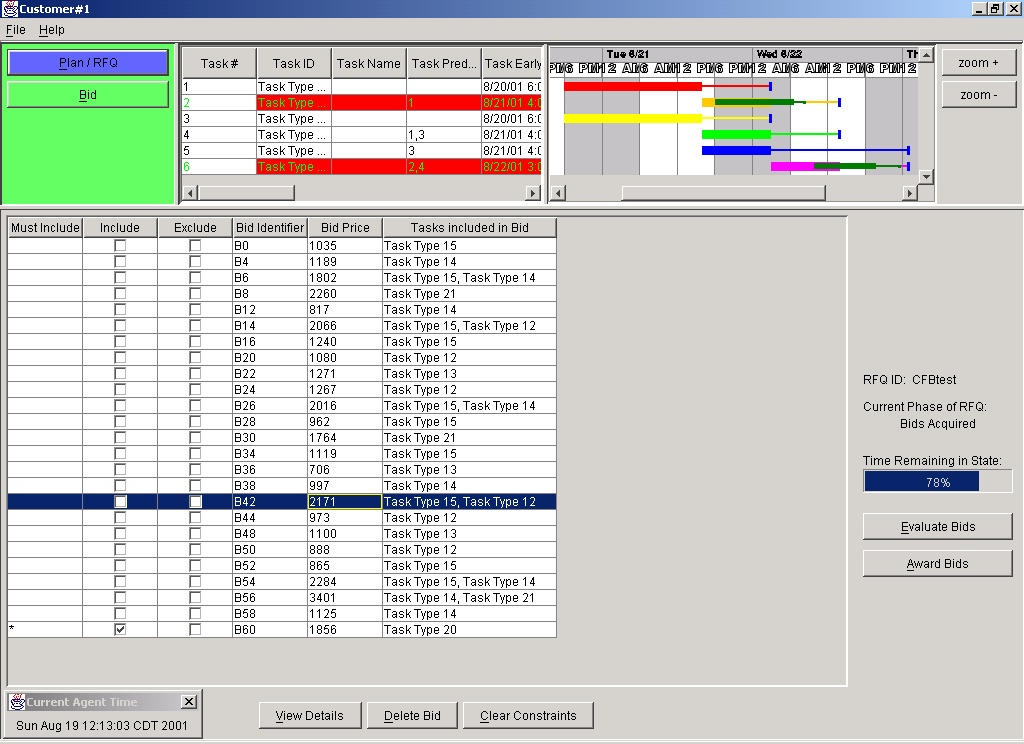CONVERSATION CAROUSEL C ONVERSATION CAROUSEL IS A ALTERNATIVE TO
WHAT TO DO BEFORE THE CONVERSATION WELCOME(WITH MERINDA EPSTEIN) 8 VOLUMES OF ‘CONVERSATIONS ABOUT MENTAL
0 FEMINIST THEORY FEMINIST CONVERSATIONS (WS 751R) EMORY INSTITUTE
053B ADVANCED CONVERSATION QUIZ 1 MARCH 17 2006 NAME
1 TWO OR MORE PERSONS HAVING A CONVERSATION 2
122121 EMOTION AND PERSONALITY IN A CONVERSATIONAL CHARACTER GENE
CONVERSATION CAROUSEL
C onversation
Carousel is a alternative to the traditional “in-class
presentation” and is an effective and engaging oral assessment
activity. Rather than have each student present a memorized monologue
in front of the class or individually to the teacher which often
takes days of teaching time and allows each student only one
opportunity to speak, this format requires all students to repeatedly
share their material with many partners, practicing and improving it
as they go along. This encourages every student to engage in a
meaningful dialogue about personally relevant subjects and permits
the teacher to assess their oral fluency while they’re involved
in one-on-one conversations with peers. It is much more natural and
real world than the traditional presentation.
onversation
Carousel is a alternative to the traditional “in-class
presentation” and is an effective and engaging oral assessment
activity. Rather than have each student present a memorized monologue
in front of the class or individually to the teacher which often
takes days of teaching time and allows each student only one
opportunity to speak, this format requires all students to repeatedly
share their material with many partners, practicing and improving it
as they go along. This encourages every student to engage in a
meaningful dialogue about personally relevant subjects and permits
the teacher to assess their oral fluency while they’re involved
in one-on-one conversations with peers. It is much more natural and
real world than the traditional presentation.
In addition to providing a very meaningful assessment format, this activity is extremely social and adaptable and be can be used to review information, ask survey questions, or carry on conversations. The strength of the carousel is that students work with and learn from many other students. It also gets them into a new room arrangement and some of them get to move around the room. Encourage students to call each other by name and use social courtesies. (Hi, how are you? Thank you for your ideas. See you next time, etc.) Teachers who are familiar with the “Inner-Outer Circles” strategy will recognize Conversation Carousel as a seated version of the same. It is more effective than Inner-Outer circle when students have a product to share like the T-Shirt activity or Facebook assessment.
When using conversation carousel as an assessment, be sure to use the same format for practice activities prior to the final assessment day. Also, you may want to have the students take notes on the information they learn from their partners.
Students might refer to this activity as “speed dating!” It operates on basically the same principal, lots of personal conversations with many partners during a limited time period.
Purpose: To practice the focus material with many partners
Time: 15-50 minutes, depending on topic and purpose of activity
Arrangements: Arrange desks in pairs with two desks facing each other. If possible arrange these pairs in a circle, or you can just use the normal room arrangement and have students pair off facing each other within that arrangement.
Materials: This activity works best when students have something in hand to talk about. It's a great way to share/present culminating projects or Cultural Participation and Research projects. The teacher needs a timer with a loud bell.
Accountability: Students will be more focused and motivated if they clearly understand how they will be graded or receive points for this activity. Teachers who keep track of participation points on a seating chart will want to circulate, listening to students and marking down points. Another method is to give each student so many colored cards. If they are off task during the activity the teacher merely pulls a card and the student receives one less point than the points possible. Filming the activity, especially if it is an assessment, will definitely
keep the students focused.
The
Language Teacher’s Handbook, 1 of 2
Procedure:
Desks/tables: Teach the students how to move the desks into the type of carousel you use. Ideally, there would be an inner circle and an outer circle of desks, each pair of desks facing each other. Most classrooms are not large enough to allow this arrangement and require a snake of paired desks.
Instructions:
1. Students pair off and move desks so that two desks are facing each other. You might allow them to pick their own first partners--they will change many times anyway.
2. Each student should have a card/object/photo to talk about or a note-taking grid.
3. Explain the purpose of the assignment and the specific directions you want followed as well as the accountability system. Tell them how much time they will have with each partner (1-5 minutes).
4. It is extremely important to clearly explain the system of rotation. Usually one side moves and the other side stays put. The teacher can count of the paired desks and show how a student moves from one to the other. Stationary partners should be prepared to guide each partner to the next spot. Skipping this step will lead to a chaotic carousel!
5. Set the timer and the students begin to talk to their partners. Teacher circulates the room taking notes or filming.
6. When time is up, the students facing one direction move one seat over and students do another round with the next partner. Continue in this fashion until students have worked with many partners.
7. If there is time, it can be fun to ask all students to jump up and complete the last rotation with the person of their choice.
Closure: Students will have learned a lot through this activity and will be able to write a lot if given a writing assignment at the end. If a grid is used to fill in information, it becomes the perfect pre-writing note sheet. Students are often very excited at the end of this activity and want to talk about it. Comments like “I didn’t know I could speak Spanish for that long!” and “I actually learned more French from talking to people during this test!” are very common at the end of a Conversation Carousel.
Evaluation: For simple guided-practice activities the teacher may just give a classwork grade of so many points or simply add participation points to the system in place. For assessment projects like MyFacebook.com, the teacher will collect the rubrics and projects and grade them later. Video really helps in this process and some teachers ask an assistant or colleague to do the filming for them for at least part of the activity.
The
Conversation Carousel often offers many pleasant surprises. Students
are very focused on the conversations and tend to stay in the target
language more than in most classroom activities. Students who have
never had the chance to converse with each other will make new
connections. Planning a conversation carousel early in the term will
help build classroom culture.
The
Language Teacher’s Handbook, pp. 27-28 COACH
- Cynthia Leathers, 2010
15 HOW CONVERSATIONS CURE THE SHIFT FROM FIGHTING TO
2 DIALOG STRUCTURE FOR TASKORIENTED CONVERSATIONS BY ANANLADA CHOTIMONGKOL
20 COMMUNITY CONVERSATION STUDY SESSION 20 COMMUNITY CONVERSATION 3
Tags: carousel c, conversation carousel, carousel, alternative, onversation, conversation
- ŠALČININKŲ RAJONO SAVIVALDYBĖS TERITORIJOS BENDRASIS PLANAS KONCEPCIJA IKI 2028
- REQUISITOS QUE HA DE CONTEMPLAR LOS INFORMES TÉCNICOS SANITARIOS
- INCUBATION PROGRAMME 2014 OF CLIMATEKIC HESSEN AS A PART
- DOSSIER DE PRENSA LA SOCIEDAD VASCONAVARRA DE PREVENCIÓN DEL
- OUAGADOUGOU HÔTEL PALM BEACH 2024 OCTOBRE 2008 RESTAURATION DE
- TC ANKARA ÜNİVERSİTESİ GAMA MESLEK YÜKSEKOKULU ANKARA ÜNİVERSİTESİ GAMA
- HARMONOGRAM AKADEMICKÉHO ROKA 20192020 NA FHI EU V BRATISLAVE
- NAME DATE CLASS HOMEWORK INVERSE CONVERSE
- UCHWAŁA NR 510 GMINNEJ KOMISJI WYBORCZEJ W NOWYM
- PRIMOŽIČ K TUJERODNE VRSTE RASTLIN IN ŽIVALI V CELINSKIH
- NOMBRE UNIDAD 3 ETAPA 2 JUGAR A +
- ZARZĄDZENIE NR 620202021 Z DNIA 1092020R DYREKTORA SZKOŁY PODSTAWOWEJ
- LADDER 123 TOOL LIST SL 99005 UPDATED 010507 CAB
- THE LINGUISTIC CREATION OF MAN CHARLES DARWIN AUGUST SCHLEICHER
- EVALUATION TEMPLATE PROGRAM CODE TITLE PRESENTER(S) DATE
- WWWSZOTAR+TIPIJAV 120811 (H HELYETT GYAKRAN T ÍRUNK) VALÓSZÍNŰSÉGSZÁMÍTÁS
- REGULAMIN RADY RODZICÓW ZESPOŁU SZKÓŁ PLASTYCZNYCH IM JÓZEFA BRANDTA
- IB ENGLISH MR DESMOND 1 OCTOBER 2018 MOTIF IN
- [ROOT8062] ADD INTERFACEINCLUDEDIRECTORIES AND NAMESPACING TO EXPORTEDIMPORTED CMAKE TARGETS
- LEMBAR PENDAFTARAN UJIAN SKRIPSI FAKULTAS USHULUDDIN UNIVERSITAS ISLAM NEGERI
- ERROR DEL SISTEMA HA OCURRIDO UN ERROR EN
- EXPRESSION OF INTEREST (EOI)FOR THE SUPPLY IMPLEMENTATION AND MAINTENANCE
- JUEVES 22 DE NOVIEMBRE DE 2012 DIARIO OFICIAL (PRIMERA
- EMAIL RETENTION GUIDELINES JUNE 2010 FOR MARION COUNTY EMPLOYEES
- FM-04-AKD-24-Form-pembimbingan-skripsi-rev-02-1
- TEACHING YOUNG FAILING BRAILLE READERS BY CHRISTINE ARTER OVERVIEW
- CONCEJO DE BOGOTA DC GESTIÓN NORMATIVA Y CONTROL POLÍTICO
- PLAČE ZA ZASEBNI SEKTOR PO KOLEKTIVNIH POGODBAH ŠIRŠE RAVNI
- INTSUB3232 SINGLE WINDOW FOR TRADE PERU SUMMARY
- BILGILENDIRILMIŞ GÖNÜLLÜ OLUR FORMU ARAŞTIRMANIN ADI LÜTFEN DİKKATLİCE
 NAME AREA EMAIL PHONE MOBILE EVELYN GLOYN NORTH GLOYNEEALINGGOVUK
NAME AREA EMAIL PHONE MOBILE EVELYN GLOYN NORTH GLOYNEEALINGGOVUKQUARRY BANK TENNIS CLUB MEMBERSHIP SECRETARY TALBOTS LANE FARRIERS
PROCEDYRY POSTĘPOWANIA W PRZYPADKACH AGRESYWNYCH ZACHOWAŃ UCZNIÓW NAUCZYCIELI I
 GUEST EQUELLA RESOURCE SUMMARY TERMS OF USE LICENCE
GUEST EQUELLA RESOURCE SUMMARY TERMS OF USE LICENCE QUESTION IN SOME QUESTION OF INTEGRATION WHERE WE CAN
QUESTION IN SOME QUESTION OF INTEGRATION WHERE WE CAN COMMON EXAM 2 PHYSICS 111 FALL 2006 NAME
COMMON EXAM 2 PHYSICS 111 FALL 2006 NAME  APPENDIX B DEPARTMENT OF PUBLIC SAFETY GAMBLING CONTROL BOARD
APPENDIX B DEPARTMENT OF PUBLIC SAFETY GAMBLING CONTROL BOARDJORD & AFFALD REF OKI DEN 16 APRIL 2010
Ðïࡱáþÿ ¥áx80ð¿bjbjt~t~466ÿÿÿÿÿÿ·&&tttttÿÿÿÿx88x88x88x88¬x88hàöööö±±±ãååååååä¢fx94ét±±±±±éttööûsss±tötöãs±ãsssöÿÿÿÿ°hx86gõpëx88çs¯0súç¬úsúts±±s±±±±±éés±±±±±±±±±±±
20095 SAYILI TEBLIĞ GEREĞI FUAR BAŞVURULARINDA DIKKAT EDILMESI GEREKEN
Ðïࡱáþÿ ¥á пebjbjàà x82j\rdjad8¢0¢0¢0¢0¢0¢0¢0¢0àcâcâcâcâcâcâcx99e ¹g¬d6¢0¢0¢0¢0¢0d¸066¢0¢0d¸0¸0¸0¢06¢06¢0àc¸0¢0àc¸0à¸0x981à366 4¢0x960 x80¹ûkããj¬+ö¢0ø3 4ô1d0adà3eh¢0eh
 RECORDATORIO VENCIMIENTO TERMINO DE RESPUESTA MPO04F035 VERSIÓN 3 22092021
RECORDATORIO VENCIMIENTO TERMINO DE RESPUESTA MPO04F035 VERSIÓN 3 22092021SUBJECT (IF APPLICABLE) INTERNAL SURROGATE CONSENT PROCESS
 PROCURADURÍA FEDERAL DE PROTECCIÓN AL AMBIENTE NORMA OFICIAL MEXICANA
PROCURADURÍA FEDERAL DE PROTECCIÓN AL AMBIENTE NORMA OFICIAL MEXICANA Integrating Mobile and Intelligent Agents in Advanced Ecommerce a
Integrating Mobile and Intelligent Agents in Advanced Ecommerce a11 JUDGES AND HUMAN RIGHTS ADDRESS BY JUSTICE CHRIS
PARAIŠKŲ ATEITININKŲ FONDO PARAMAI GAUTI TEIKIMO IR NAGRINĖJIMO TAISYKLĖS
UNIVERSITY OF ULSTER APPLICATION FOR SPECIAL LEAVE NOTES FOR
EL CRACK DE 1929 1 INTRODUCCIÓN EL 24
 ESEJ CO NOVÉHO MI DALA VÝUKA SOR? UKÁZKY Z
ESEJ CO NOVÉHO MI DALA VÝUKA SOR? UKÁZKY Z